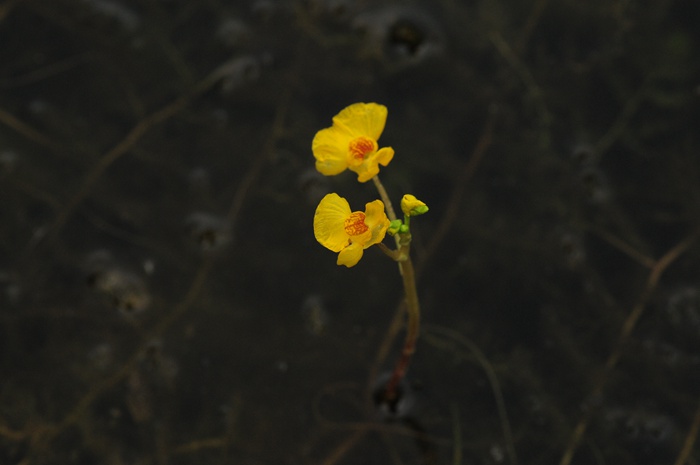- Scientific Name: Utricularia australis R.Br.
- Ref: Prodr. Fl. Nov. Holland.:430. 1810
- Synonyms:
- Utricularia australis f. fixa (Komiya) Komiya & C.Shibata
- U. australis f. tenuicaulis (Miki) Komiya & C.Shibata
- U. dubia Rosell. ex Ces., Pass. & Gibelli
- U. galloprovincialis J.Gay ex Webb
- U. incerta Kamienski
- U. jankae Velen.
- U. japonica Makino
- U. mairii Cheeseman
- U. major Schmidel
- U. mutata (Döll) Leiner
- U. neglecta Lehm.
- U. pollichii F.W.Schultz
- U. protrusa Hook.f.
- U. sacciformis Benj.
- U. siakujiiensis S.Nakaj. ex H.Hara
- U. tenuicaulis Miki
- U. vulgaris f. fixa Komiya
- U. vulgaris f. tenuicaulis (Miki) Komiya
- English Common Name: southern bladderwort
- Chinese Common Name: 南方狸藻 nánfāng lízǎo
- Japanese Common Name: イヌタヌキモ [犬狸藻] inutanukimo
- Family: Lentibulariaceae
- Genus: Utricularia
- Distribution: Lakes, pools, river backwaters, ditches, rice fields; near sea level to 2500 m. Anhui, Chongqing, Fujian, Guangdong, Guangxi, Guizhou, Hainan, Hubei, Hunan, Jiangsu, Jiangxi, S Shaanxi, Sichuan, Taiwan, Xizang, Yunnan, Zhejiang [Afghanistan, Bhutan, India, Indonesia, Japan, Kashmir, Korea, Mongolia, Myanmar, Nepal, Pakistan, Papua New Guinea, Philippines, Russia (Sakhalin), Sri Lanka; Africa, SW Asia, Australia, Europe, Pacific islands (New Zealand)].
Perennials, suspended aquatic. Rhizoids usually present, filiform, bearing numerous short dichotomously divided branches. Stolons filiform, branched. Traps on leaf segments, stalked, ovoid, 0.5-2.5 mm, mouth lateral or basal; appendages 2, dorsal, simple or branched, setiform, with shorter simple lateral setae. Leaves numerous, 1.5-4 cm, divided from base into 2 ± equal primary segments; primary segment ovate, elliptic, or ovate-oblong in outline, pinnately divided into secondary segments; secondary segments dichotomously divided into further segments; ultimate segments capillary, slightly flattened, margin sparsely denticulate, apex and teeth setulose. Inflorescences erect, (5-)10-30 cm, 3-8-flowered, glabrous; peduncle terete, 1-2 mm thick; scales 1-3, similar to bracts; bracts basifixed, suborbicular, 2-5 mm, base auriculate, apex rounded and obscurely tridentate. Pedicel erect at anthesis but decurved in fruit, terete, 1-2.5 cm; bracteoles absent. Calyx lobes ovate, 3-4 mm, subequal; lower lobe apex emarginate; upper lobe apex rounded. Corolla yellow, 1.2-1.5 cm; lower lip transversely elliptic, base with a prominent swelling, apex rounded to retuse; spur broadly conic, considerably shorter than corolla lower lip, slightly curved, apex obtuse; palate glabrous; upper lip broadly ovate, apex retuse. Filaments ca. 2 mm, curved; anther thecae distinct. Ovary globose, densely covered with sessile glands; style evident; stigma lower lip semicircular and ciliate, upper lip very short or obsolete. Capsule globose, 3-4 mm in diam., circumscissile. Seeds prismatic, 0.5-0.6 × 0.5-0.7 mm, 4-6 angled, narrowly winged on all angles; seed coat with small prominent slightly elongate reticulations. Fl. Jun-Nov, fr. Jul-Dec. 2n = 40, 44. (Flora of China)
